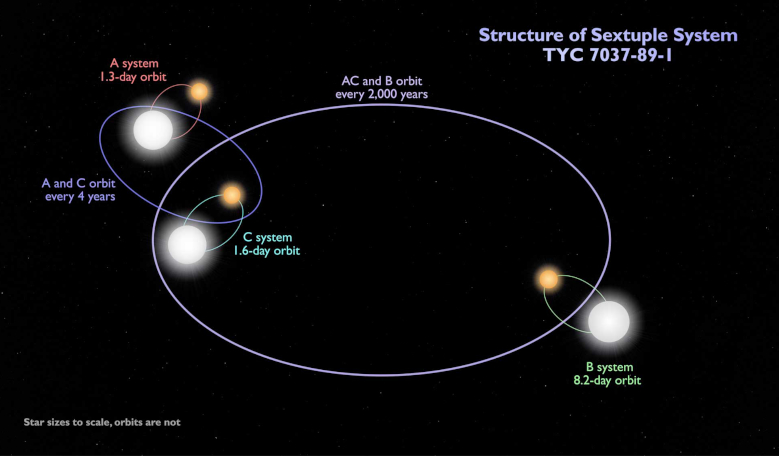Scientists using NASA’s Transiting Exoplanet Survey Satellite (TESS) have discovered the first six-star system ever found where all of the stars participate in eclipses, which when seen from our Earthly perspective, last from every few hours to a few days.
Located about 1,900 light-years away in the constellation Eridanus is TYC 7037-89-1; a triple-binary sextuple star system.
That in itself is quite exceptional as to date, only 17 such systems – none of which are all eclipsing – have been identified from within the billions of stars known to populate our galaxy.
The large majority of discovered multi-star systems are quadruples, followed by triples. But thanks to TESS this number is set to rise, as the satellite continues to sweep the entire sky looking for objects of interest in an extended mission that will end sometime late in 2022.
TESS identifies potentially exciting objects by detecting a minute drop in visible light coming from a star when an object passes in front of it - an occurrence known as a transit.
Although the spacecraft is looking primarily for exoplanets, researchers can use the same method to find multi-star systems; a practise that has recently netted a 40+ strong international team of astronomers with a huge find of 100 systems with potentially three or more stars.
As part of the find, the team also collated new data on TYC 7037-89-1. TYC 7037-89-1, also known as TIC 168789840, had previously been detected before in another large star survey, but its true multiplicity nature lay hidden at the time.
After using archival data and follow-up observations from ground-based facilities, the team headed by Brian Powell at GSFC, who made the discovery with fellow astrophysicist Veselin Kostov also at Goddard, were able to discern its rare configuration and have since designated the binaries within the system by the letters A, B, and C for greater clarification.
The inner binary pair are known separately as A and C whereas the outer binary is known as binary B (labelled so according to order of discovery).
The stars in the A and C systems orbit each other roughly every day and a half, while the two binaries orbit each other about every four years.
The members in binary B on the other hand circle each other about every eight days, but the pair is much farther away, orbiting around the inner systems roughly every 2,000 years.
The primary stars in all three binaries are all slightly bigger and more massive than the Sun say Powell and colleagues and their companion stars are all approximately half the Sun’s size and are around a third as hot.
Aside from being naturally fascinating, multi-star systems are of interest to astronomers because a whole host of measurements can be determined from the one detection, such as the stars’ sizes, masses, temperatures, and separation and more crucially, their distance from Earth.
In addition, many studies have shown that all low-mass stars like our Sun are born in pairs. Finding TYC 7037-89-1 is therefore a boon for astronomers because its unusual structure and orientation, can provide important new insight into the evolution of multiple star systems.
The team plan on observing TYC 7037-89-1 further to reveal, amongst other things, if the intermediate and outer orbital planes are all aligned with the planes of the three inner eclipsing binaries.











